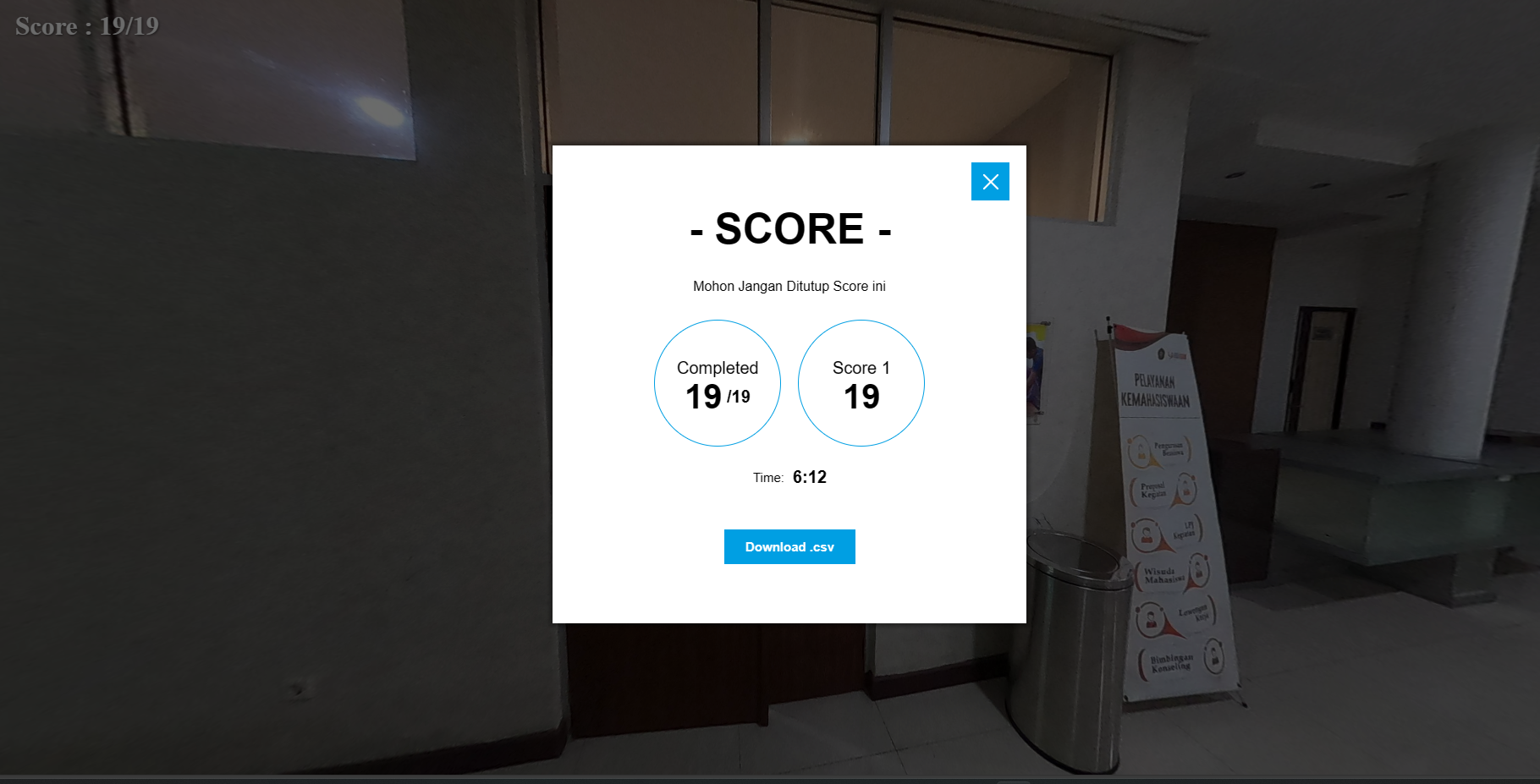Performance Analysis of Virtual Tour Navigation Guides for Landmark Recognition
Analisis Performa Panduan Navigasi Pada Pengenalan Ruang Berbasis Virtual Tour
DOI:
https://doi.org/10.21070/joincs.v7i1.1627Keywords:
virtual environment, virtual tours, linear exploration, free explorationAbstract
Abstract. Virtual Tour Navigation should make it easy for beginners to find all the places in the virtual environment and allow them to remember or gain landmark knowledge about the virtual environment being explored. Navigation guides help novices to find and reach locations quickly, but the use of guides can reduce the acquisition of spatial knowledge because users are less active in encoding the environment into spatial working memory. Generally, users can move between locations using navigation arrows on the virtual tour. All navigation arrows are displayed to be able to move throughout the room according to the user's wishes, which we call non-linear or free navigation. This causes beginners to get lost and fail to find all locations. This research proposes a user guide in Virtual Tour by limiting user exploration. User exploration can only be done linearly where certain navigation arrows appear gradually every time a room is found. To prevent users from getting lost, navigation arrows are coloured differently when heading to locations they have already visited. This research was applied to virtual tours based on 360 panoramic photos. The test results showed that virtual tours that used linear navigation guides obtained faster completion times than virtual tours with non-linear navigation. In testing landmark knowledge, there was no significant difference between linear and non-linear virtual tours. This shows that the guidelines proposed by the researchers do not cause a decrease in spatial learning outcomes and still provide advantage in navigation time.
References
[2] I. E. Lokka and A. Çöltekin, “Toward optimizing the design of virtual environments for route learning: empirically assessing the effects of changing levels of realism on memory,” Int J Digit Earth, vol. 12, no. 2, pp. 137–155, Feb. 2019, doi: 10.1080/17538947.2017.1349842.
[3] A. Klippel et al., “Direction Concepts in Wayfinding Assistance Systems,” 2004. Accessed: Mar. 30, 2023. [Online]. Available: https://people.geog.ucsb.edu/~montello/pubs/Klippel04.pdf
[4] C. Johanson, C. Gutwin, and R. Mandryk, “Trails, rails, and over-reliance: How navigation assistance affects route-finding and spatial learning in virtual environments,” Int J Hum Comput Stud, vol. 178, p. 103097, Oct. 2023, doi: 10.1016/J.IJHCS.2023.103097.
[5] T. Widiyaningtyas, D. D. Prasetya, and A. P. Wibawa, “Adaptive Campus Virtual Tour using Location-Based Services,” in 2018 Electrical Power, Electronics, Communications, Controls and Informatics Seminar (EECCIS), 2018, pp. 419–423. doi: 10.1109/EECCIS.2018.8692853.
[6] N. D. Retnowati and D. Nugraheny, “VIRTUAL TOUR OF SADENG BEACH TOURISM ROUTE USING THE MULTIMEDIA DEVELOPMENT LIFE CYCLE METHOD,” ANGKASA, vol. 12, no. 1, pp. 52–63, 2020, doi: http://dx.doi.org/10.28989/angkasa.v12i1.578.
[7] G. N. M. Nata, S. Anthony, and P. P. Yudiastra, “Knowledge Discovery And Virtual Tour To Support Tourism Promotion,” IAIC Transactions on Sustainable Digital Innovation (ITSDI), vol. 2, no. 2, pp. 94–106, Nov. 2020, doi: 10.34306/itsdi.v2i2.387.
[8] R. B. Rohizan, D. M. Vistro, and M. R. Bin Puasa, “Enhanced Visitor Experience Through Campus Virtual Tour,” J Phys Conf Ser, vol. 1228, no. 1, p. 12067, May 2019, doi: 10.1088/1742-6596/1228/1/012067.
[9] Y.-F. Tsai and M. Peterson, “The Effects of Route Guidance on Spatial Learning,” pp. 469–474, doi: 10.17077/drivingassessment.1434.
[10] J. L. Adler, “Investigating the learning effects of route guidance and traffic advisories on route choice behavior,” Transp Res Part C Emerg Technol, vol. 9, no. 1, pp. 1–14, Feb. 2001, doi: 10.1016/S0968-090X(00)00002-4.
[11] E. Ben-Elia, “An exploratory real-world wayfinding experiment: A comparison of drivers’ spatial learning with a paper map vs. turn-by-turn audiovisual route guidance,” Transp Res Interdiscip Perspect, vol. 9, p. 100280, Mar. 2021, doi: 10.1016/J.TRIP.2020.100280.
[12] H. Heft, K. Schwimmer, and T. Edmunds, “Assessing the Effect of a Visual Navigational System on Route-Learning From an Ecological Perspective,” Front Psychol, vol. 12, p. 645677, Jul. 2021, doi: 10.3389/FPSYG.2021.645677/BIBTEX.
[13] P. W. Thorndyke and C. Stasz, “Individual differences in procedures for knowledge acquisition from maps,” Cogn Psychol, vol. 12, no. 1, pp. 137–175, Jan. 1980, doi: 10.1016/0010-0285(80)90006-7.
[14] P. W. Thorndyke and B. Hayes-Roth, “Differences in spatial knowledge acquired from maps and navigation,” Cogn Psychol, vol. 14, no. 4, pp. 560–589, Oct. 1982, doi: 10.1016/0010-0285(82)90019-6.






